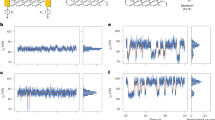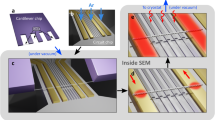Abstract
Carbon nanotube transistors combine molecular-scale dimensions with excellent electronic properties, offering unique opportunities for chemical and biological sensing. Here, we form supported lipid bilayers over single-walled carbon nanotube transistors. We first study the physical properties of the nanotube/supported lipid bilayer structure using fluorescence techniques. Whereas lipid molecules can diffuse freely across the nanotube, a membrane-bound protein (tetanus toxin) sees the nanotube as a barrier. Moreover, the size of the barrier depends on the diameter of the nanotube—with larger nanotubes presenting bigger obstacles to diffusion. We then demonstrate detection of protein binding (streptavidin) to the supported lipid bilayer using the nanotube transistor as a charge sensor. This system can be used as a platform to examine the interactions of single molecules with carbon nanotubes and has many potential applications for the study of molecular recognition and other biological processes occurring at cell membranes.
This is a preview of subscription content, access via your institution
Access options
Subscribe to this journal
Receive 12 print issues and online access
$259.00 per year
only $21.58 per issue
Buy this article
- Purchase on Springer Link
- Instant access to full article PDF
Prices may be subject to local taxes which are calculated during checkout





Similar content being viewed by others
References
McEuen, P. L. Single-wall carbon nanotubes. Phys. World 13, 31–36 (June 2000).
Kong, J. et al. Nanotube molecular wires as chemical sensors. Science 287, 622–625 (2000).
Star, A., Gabriel, J. C. P., Bradley, K. & Gruner, G. Electronic detection of specific protein binding using nanotube FET devices. Nano Lett. 3, 459–463 (2003).
Besteman, K., Lee, J. O., Wiertz, F. G. M., Heering, H. A. & Dekker, C. Enzyme-coated carbon nanotubes as single-molecule biosensors. Nano. Lett. 3, 727–730 (2003).
Kong, J., Soh, H. T., Cassell, A. M., Quate, C. F. & Dai, H. J. Synthesis of individual single-walled carbon nanotubes on patterned silicon wafers. Nature 395, 878–881 (1998).
Zhou, X. J., Park, J. Y., Huang, S. M., Liu, J. & McEuen, P. L. Band structure, phonon scattering, and the performance limit of single-walled carbon nanotube transistors. Phys. Rev. Lett. 95, 146805 (2005).
Rosenblatt, S. et al. High performance electrolyte gated carbon nanotube transistors. Nano Lett. 2, 869–872 (2002).
Brian, A. A. & McConnell, H. M. Allogeneic stimulation of cytotoxic T cells by supported planar membranes. Proc. Natl Acad. Sci. USA 81, 6159–6163 (1984).
Sackmann, E. Supported membranes: scientific and practical applications. Science 271, 43–48 (1996).
Richard, C., Balavoine, F., Schultz, P., Ebbesen, T. W. & Mioskowski, C. Supramolecular self-assembly of lipid derivatives on carbon nanotubes. Science 300, 775–778 (2003).
Salafsky, J., Groves, J. T. & Boxer, S. G. Architecture and function of membrane proteins in planar supported bilayers: A study with photosynthetic reaction centers. Biochemistry 35, 14773–14781 (1996).
Mossman, K. D., Campi, G., Groves, J. T. & Dustin, M. L. Altered TCR signaling from geometrically repatterned immunological synapses. Science 310, 1191–1193 (2005).
Ye, J. S. et al. Self-assembly of bilayer lipid membrane at multiwalled carbon nanotubes towards the development of photo-switched functional device. Electrochem. Commun. 7, 81–86 (2005).
Artyukhin, A. B. et al. Functional one-dimensional lipid bilayers on carbon nanotube templates. J. Am. Chem. Soc. 127, 7538–7542 (2005).
Bradley, K., Davis, A., Gabriel, J. C. P. & Gruner, G. Integration of cell membranes and nanotube transistors. Nano Lett. 5, 841–845 (2005).
Axelrod, D., Koppel, D. E., Schlessinger, J., Elson, E. & Webb, W. W. Mobility measurement by analysis of fluorescence photobleaching recovery kinetics. Biophys. J. 16, 1055–1069 (1976).
Magde, D., Elson, E. L. & Webb, W. W. Fluorescence correlation spectroscopy. II. Experimental realization. Biopolymers 13, 29–61 (1974).
Orth, R. N. et al. Creating biological membranes on the micron scale: Forming patterned lipid bilayers using a polymer lift-off technique. Biophys. J. 85, 3066–3073 (2003).
Groves, J. T., Ulman, N. & Boxer, S. G. Micropatterning fluid lipid bilayers on solid supports. Science 275, 651–653 (1997).
Ajo-Franklin, C. M., Yoshina-Ishii, C. & Boxer, S. G. Probing the structure of supported membranes and tethered oligonucleotides by fluorescence interference contrast microscopy. Langmuir 21, 4976–4983 (2005).
Stryer, L. Fluorescence energy transfer as a spectroscopic ruler. Annu. Rev. Biochem. 47, 819–846 (1978).
Parthasarathy, R., Yu, C. H. & Groves, J. T. Curvature-modulated phase separation in lipid bilayer membranes. Langmuir 22, 5095–5099 (2006).
Roux, A. et al. Role of curvature and phase transition in lipid sorting and fission of membrane tubules. EMBO J. 24, 1537–1545 (2005).
van Meer, G. & Vaz, W. L. Membrane curvature sorts lipids. Stabilized lipid rafts in membrane transport. EMBO Rep. 6, 418–419 (2005).
Moran-Mirabal, J. M. et al. Micrometer-sized supported lipid bilayer arrays for bacterial toxin binding studies through total internal reflection fluorescence microscopy. Biophys. J. 89, 296–305 (2005).
Angstrom, J., Teneberg, S. & Karlsson, K. A. Delineation and comparison of ganglioside-binding epitopes for the toxins of Vibrio cholerae, Escherichia coli, and Clostridium tetani: evidence for overlapping epitopes. Proc. Natl Acad. Sci.USA 91, 11859–11863 (1994).
Graneli, A., Yeykal, C. C., Robertson, R. B. & Greene, E. C. Long-distance lateral diffusion of human Rad51 on double-stranded DNA. Proc. Natl Acad. Sci. USA 103, 1221–1226 (2006).
Pesen, D. & Hoh, J. H. Micromechanical architecture of the endothelial cell cortex. Biophys. J. 88, 670–679 (2005).
Bonetta, L. Spectrin is peripheral. J. Cell. Biol. 170, 12 (2005).
Tank, D. W., Wu, E. S. & Webb, W. W. Enhanced molecular diffusibility in muscle membrane blebs: release of lateral constraints. J. Cell. Biol. 92, 207–212 (1982).
Kusumi, A., Ike, H., Nakada, C., Murase, K. & Fujiwara, T. Single-molecule tracking of membrane molecules: plasma membrane compartmentalization and dynamic assembly of raft-philic signaling molecules. Semin. Immunol. 17, 3–21 (2005).
Chaiet, L. & Wolf, F. J. Properties of streptavidin biotin-binding protein produced by streptomycetes. Arch. Biochem. Biophys. 106, 1–5 (1964).
Artyukhin, A. B. et al. Controlled electrostatic gating of carbon nanotube FET devices. Nano Lett. 6, 2080–2085 (2006).
Groves, J. T., Wulfing, C. & Boxer, S. G. Electrical manipulation of glycan-phosphatidyl inositol-tethered proteins in planar supported bilayers. Biophys. J. 71, 2716–2723 (1996).
Ng, J. M. K., Gitlin, I., Stroock, A. D. & Whitesides, G. M. Components for integrated poly(dimethylsiloxane) microfluidic systems. Electrophoresis 23, 3461–3473 (2002).
Larrimore, L., Nad, S., Zhou, X. J., Abruna, H. & McEuen, P. L. Probing electrostatic potentials in solution with carbon nanotube transistors. Nano Lett. 6, 1329–1333 (2006).
Acknowledgements
This work was supported by the Nanobiotechnology Center (NBTC), an STC Program of the National Science Foundation under Agreement No. ECS-9876771. J.M.M. thanks CONACyT for support through its graduate fellowship programme. Sample fabrication was performed at the Cornell Nanoscale Science & Technology Facility, a member of the National Nanotechnology Infrastructure Network, which is supported by the National Science Foundation (Grant ECS 03-35765).
Author information
Authors and Affiliations
Contributions
X.Z. and J.M. performed the experiments and analysed the data. All the authors discussed the results and co-wrote the manuscript.
Corresponding authors
Ethics declarations
Competing interests
The authors declare no competing financial interests.
Supplementary information
Supplementary Information
Supplementary figures S1—S3 (PDF 235 kb)
Rights and permissions
About this article
Cite this article
Zhou, X., Moran-Mirabal, J., Craighead, H. et al. Supported lipid bilayer/carbon nanotube hybrids. Nature Nanotech 2, 185–190 (2007). https://doi.org/10.1038/nnano.2007.34
Received:
Revised:
Accepted:
Published:
Issue Date:
DOI: https://doi.org/10.1038/nnano.2007.34
This article is cited by
-
Hybrid bilayer membranes as platforms for biomimicry and catalysis
Nature Reviews Chemistry (2022)
-
Ionic contrast across a lipid membrane for Debye length extension: towards an ultimate bioelectronic transducer
Nature Communications (2021)
-
Reconstitution and real-time quantification of membrane remodeling by single proteins and protein complexes
Nature Protocols (2020)
-
Carbon Nanotubes in Biomedicine
Topics in Current Chemistry (2020)
-
Surface Sensitive Analysis Device using Model Membrane and Challenges for Biosensor-chip
BioChip Journal (2020)



